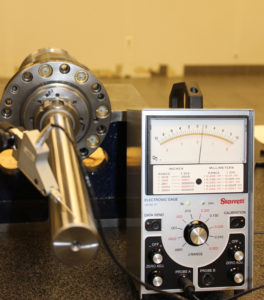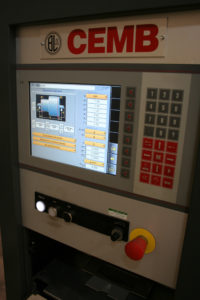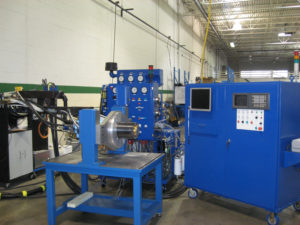5 Ways to Extend CNC Spindle Life
Early attention to performance issues and insisting on painstaking rebuild/remanufacturing procedures can help machine tool operators keep their spindles on the job.
 For most manufacturers, the productivity of their CNC equipment can be measured in fractions of seconds, including not only the cutting or grinding cycle times, but even the intervals between tool changes. The performance of the spindle, the workhorse of the CNC machine, has a dramatic impact on that productivity.
For most manufacturers, the productivity of their CNC equipment can be measured in fractions of seconds, including not only the cutting or grinding cycle times, but even the intervals between tool changes. The performance of the spindle, the workhorse of the CNC machine, has a dramatic impact on that productivity.
When operating problems, such as excessive vibration or chatter, hinders machining efficiency, productivity may be crippled until the spindle is replaced. If no spare is available, repairing or remanufacturing the spindle could take weeks effectively putting a machine out of business in the meantime.
Identify when to repair – before failure
Normally when a customer pulls a spindle it is because of part quality issues and/or intensified noise level.
“Noise often results from damaged bearings creating vibration that may eventually lead to chatter, a more severe vibration that feeds upon itself,” explains David Kirkpatrick, president of Superior Spindle Service (Taylor, MI), a company that specializes in rebuilding,  grinding and machining of machine tool spindles. “Chatter often creates waves in machined surfaces to the point where the parts being are out of tolerance and must be scrapped.”
grinding and machining of machine tool spindles. “Chatter often creates waves in machined surfaces to the point where the parts being are out of tolerance and must be scrapped.”
Another immediate and serious consequence of chatter relates to spindle efficiency. Many manufacturers deal with chatter by setting their machining parameters low. Instead of tool strength and spindle horsepower defining the metal removal rate, chatter becomes the limiting factor that keeps the process from reaching its potential.
The solution for operators of CNC equipment is predictive maintenance. This requires regular monitoring of operating parameters and maintaining disciplined, detailed records. For example, vibration analysis should be monitored and recorded at appropriate intervals, perhaps quarterly or even monthly.
Look to a remanufacturing specialist
When CNC spindle repair or replacement is needed, a remanufacturing specialist can often provide more comprehensive spindle services, sometimes also including repair of related motors, encoders, proximity sensors and drawbars.
 Some spindle remanufacturers, such as Superior Spindle Service, offer one-stop repair services. Because there is a direct relationship between spindle performance and the proper function of these other components, it is critical that the precision spindle repair facility be able to evaluate and service all spindle components.
Some spindle remanufacturers, such as Superior Spindle Service, offer one-stop repair services. Because there is a direct relationship between spindle performance and the proper function of these other components, it is critical that the precision spindle repair facility be able to evaluate and service all spindle components.
“Service technicians meticulously should disassemble and check each spindle for adherence with the original manufacturer’s specifications,” Kirkpatrick explains. “This is followed by a geometric inspection using electronic measuring equipment that is repeatable within a micron. It is advantageous that a digital photo record be kept to insure that all repair quotes and failure analysis reports are as accurate as possible. Next, grinding, machining and balancing should be performed by experienced technicians using advanced manufacturing equipment.”
Kaizen-type innovation and improvements
Kirkpatrick says there is much room for Kaizen-type improvement throughout the remanufacturing process. In one case his firm was working with a major automotive manufacturer who was experiencing excessive downtime, over 31 hours, each time they had to change a spindle.
Superior Spindle Services was able to extend spindle life by incorporating specific modifications. As a result, the customer’s average spindle downtime was reduced to less than 10 hours, an accomplishment for which the spindle remanufacturer received a Kaizen Award.
Require failure reports
For every CNC spindle repair, customers should expect to have a detailed failure report including text and photos.
“This process provides the customer with documentation of the rebuilder’s findings concerning the causes of failures,” says Kirkpatrick. “This is vital because it can help customers take corrective actions to prevent future failures.”
Kirkpatrick says that his firm also provides customers with recommendations that may increase spindle service life. In some cases, application engineers might suggest ceramic (silicon nitride) ball bearings be used to replace conventional steel ball bearings. The ceramic ball bearings have 30% more mass than steel ball bearings and allow spindles to operate at higher speeds.
Expect advanced testing and verification
After spindles are remanufactured, it is vital they be thoroughly tested and verified. If related assemblies are in question, such as electronics or motors, those should be tested and verified as well.
“Advanced testing includes vibration analysis and running the spindle closed-loop on a Siemens or a Fanuc drive,” Kirkpatrick explains. “Our technicians also align encoders using special software. We also test motor thermistors, bearing thermistors and proximity sensors.”
Each rebuilt spindle needs to be thoroughly “run in” at the operating speeds as they were designed. Vibration analysis and temperatures are monitored throughout the run in procedure and may take up to 18 hours to complete. Before leaving the testing facility, detailed reports should be generated for verification by Quality Assurance Technicians.
For more information, contact Superior Spindle Services, LLC; 25377 Brest Road, Taylor, MI 48180; Phone: toll-free (877) 946-7400, (734) 946-4646; Fax (734) 946-4851; E-mail: dkirkpatrick@superiorspindle.com; or visit the web site www.superiorspindle.com.



















